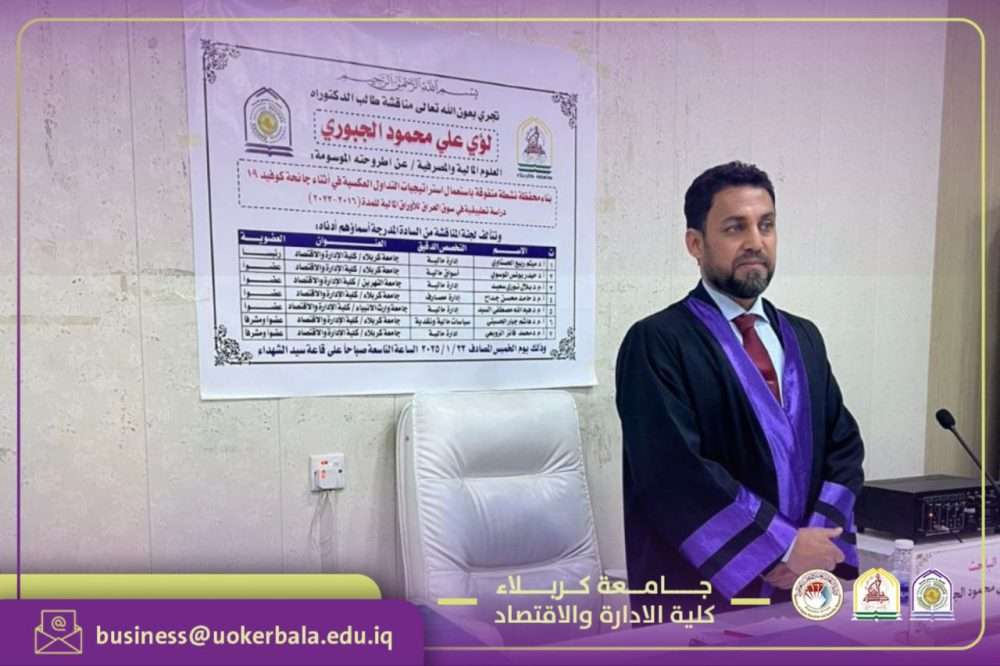(An applied study in the Iraqi Stock Exchange for the period 2016-2023)
A dissertation submitted to the council of the college Administration and economics university of Kerbala, as a partial fulfillment of the requirements to obtain Ph.D. Degree in the financial and banking sciences.
By:
Luay Ali Mahmood Al-Jubouri
Supervised by:
| Associate Prof. Dr. Hashim Jabbar Hussein | Associate Prof. Dr. Mohammed Faez Hasan |
Abstract:
The technical analysis approach is considered one of the fundamental bases relied upon by traders in financial markets. These methods are characterized by their diversity and the differing ways in which they are utilized by traders. In this context, the reverse trading strategy emerges as one of the effective techniques in technical analysis, relying on the analysis of historical and current return trends to predict future market movements by exploiting rapid price changes.
The study’s core debate revolves around key questions regarding the feasibility of building a regular stock portfolio using reverse trading strategies in the Iraqi stock market, the impact of transaction costs on the regular stock portfolio, and the extent to which reverse strategies achieve risk-adjusted profits in the Iraqi stock market (with and without transaction costs) compared to the market portfolio. Accordingly, the study aimed to build a regular stock portfolio using reverse trading strategies in the Iraqi stock market, to identify the effect of transaction costs on the regular stock portfolio (with and without transaction costs), and to uncover the reverse strategies that achieved risk-adjusted profits in the Iraqi stock market (with and without transaction costs) during the study period compared to the market portfolio.
To this end, the study relied on daily closing price data for 31 Iraqi listed companies that maintained continuous trading during the sample period from January 2020 to December 2023. Using (Ms. Excel 2019) and (Spss. V25), stock selection models were prepared to build reverse portfolios with their components (winning and losing portfolios) for each strategy, as well as the corresponding market portfolio, and to calculate their characteristics in terms of return and risk. Additionally, the necessary statistical and financial tests were conducted to verify the results derived from the analyses.
The study reached several conclusions, the most important of which is that the results proved that transaction costs do not affect reverse returns, indicating that the portfolio strategies were effective enough to overcome the effects of transaction costs. As for the winning and losing portfolios, they were statistically insignificant with and without costs, achieving lower returns than the reverse portfolio. The study also demonstrated that reverse strategies vary in achieving risk-adjusted profits in the Iraqi stock market (with and without transaction costs) during the study period compared to the market portfolio for the Sharpe measure. It was noted that all reverse portfolios did not achieve risk-adjusted performance but rather exhibited negative performance, as these portfolios did not yield returns exceeding those that could be obtained from risk-free investments. Conversely, the study revealed that the reverse strategy excelled in terms of risk-adjusted returns for the Treynor index, achieving positive returns that exceeded those of the market. This indicates that the reverse strategy proved its effectiveness and achieved risk-adjusted returns compared to the market, demonstrating its capability to deliver good returns relative to the risks faced.
The study concluded with several recommendations, the most important being: investors are advised to adopt the reverse strategy as a primary investment option, given its superiority in achieving risk-adjusted returns according to the Treynor measure, as 19 reverse strategies exhibited positive performance compared to only 3 strategies achieved by the market.
Keywords: Reverse trading strategy, stock portfolio, transaction costs.































































